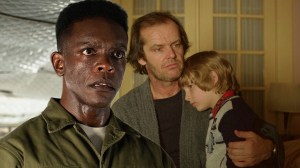Long before she became synonymous with heartwarming holiday romances, Lacey Chabert ventured into much darker Christmas territory with a role in 2006’s controversial slasher remake Black Christmas. The film, which reimagined Bob Clark’s influential 1974 horror classic, was part of a wave of mid-2000s horror remakes that attracted rising young television stars. Directed by former X-Files writer Glen Morgan, the production assembled an impressive ensemble, including Buffy the Vampire Slayer alumnus Michelle Trachtenberg, future Scott Pilgrim star Mary Elizabeth Winstead, and Arrowverse fixture Katie Cassidy.
Videos by ComicBook.com
Morgan, fresh off directing 2003’s Willard remake, approached the project with reverence for the original film. The director’s determination to “take the film to a different level” while “respecting the fact that [the original] was a great movie to begin with” guided his vision for the remake, according to co-star Crystal Lowe in the BTS documentary, What Have You Done? The Remaking of Black Christmas.
The story follows a group of sorority sisters who find themselves stalked by a deranged killer during a Christmas Eve blackout. Morgan expanded the original film’s mythology by creating an extensive backstory for the antagonist Billy Lenz, drawing inspiration from real-life serial killer Edmund Kemper. The plot reveals Billy’s tragic origin as a jaundiced child subjected to horrific abuse by his mother, eventually leading to murder and the introduction of a second killer — his sister Agnes.
RELATED: Netflix Christmas Movie Universe: Every Connection Between the Holiday Films
Chabert, who appeared in the film between her iconic role in Mean Girls and her eventual Hallmark career, took on the role of Dana Mathis, a privileged sorority sister. The production proved physically demanding for the actress — on her first day shooting a fight scene, Chabert injured her leg and had to fly to Los Angeles for medical attention. However, demonstrating the work ethic that would later make her a holiday movie staple, she returned to set the very next day to continue filming, per The Remaking of Black Christmas.
The film’s December 25, 2006 release date sparked controversy naturally, with several religious groups condemning Dimension Films’ decision to open a horror movie on Christmas Day. The studio defended the choice, noting “there is a long tradition of releasing horror movies during the holiday season as counter-programming to the more regular yuletide fare.”
Critics were largely unimpressed with the remake, which currently holds a 14% approval rating on Rotten Tomatoes. However, the film did manage to gross $21.5 million worldwide against its $9 million budget and earned $30.1 million in home video sales.
The contrast between Chabert’s role in this bloody holiday offering and her current status as Hallmark’s Christmas queen couldn’t be more stark. The actress recently celebrated filming her 40th movie for the network, reflecting to People magazine, “It’s crazy, right?! I’m so, so proud of it. I never would’ve known when I did the first one that it would turn into what it has.”
Now 42, Chabert has fully embraced her position as a holiday movie icon, starring in both Hallmark’s A Christmas Quest and Netflix’s Hot Frosty this season.
“Everyone knows I love Christmas and I love, love, love making these Christmas movies,” she told People. “So to have the opportunity to expand and do that twice this year was just such an exciting experience.”
Her journey from Black Christmas to becoming what co-star Kristoffer Polaha calls “the GOAT of holiday films” shows her versatility as an actress. While the 2006 slasher may not have earned the same warm reception as her current festive fare, it represents an interesting chapter in both horror remake history and Chabert’s evolving career.
The Black Christmas remake, while contentious, helped pave the way for other holiday horror offerings. Morgan’s film took a distinctive approach to the subgenre, eschewing typical high-energy slasher movie pacing for a more methodical approach that gradually builds tension before delivering its violent scenes.
The production itself faced numerous challenges beyond its divisive release date. Morgan and producer James Wong experienced frequent conflicts with Dimension Films executives Bob and Harvey Weinstein over the film’s tone and ending. The studio demanded significant changes to Morgan’s original conclusion, which would have paid homage to the 1974 film with a phone call from Billy to the survivors, per The Anatomy of Fear: Conversations with Cult Horror and Science-Fiction Filmmakers. Instead, the theatrical version ended with a more violent finale featuring Billy’s death by Christmas tree ornament.
The Weinsteins’ intervention extended to marketing materials, with additional footage shot specifically for trailers and TV spots without Morgan’s involvement. This included scenes of Trachtenberg wielding a shotgun and delivering the line “Merry Christmas, motherf-cker” directly to the camera, along with various other sequences that never appeared in the final film.
Despite these creative conflicts, the film assembled an impressive young cast eager to subvert their typical roles. Trachtenberg, for instance, specifically chose the project because it offered her the chance to “die” on screen after her tenure on Buffy the Vampire Slayer. The production also featured Andrea Martin, who had appeared in the 1974 original, creating a connection between the two versions.
The film’s practical effects and atmospheric cinematography presented unique challenges, particularly given that much of the action takes place during a blackout. According to The Remaking of Black Christmas, the crew had to devise creative solutions for lighting scenes, including cutting holes in the walls to achieve the desired effects while maintaining the dark atmosphere.
Looking back, Black Christmas represents a unique intersection of horror and holiday cinema that stands apart from more lighthearted seasonal fare like Gremlins or Jack Frost. By combining cheerful holiday elements with horror, this peculiar subgenre ensures its survival and fuels its enduring appeal.
For Chabert, the film marks a fascinating counterpoint to her current holiday persona. While she now specializes in heartwarming romances that celebrate the season’s joy and magic, her role in Black Christmas explored the darker possibilities of yuletide storytelling. This versatility has helped establish her as one of the most prolific and beloved actresses in holiday entertainment, even as she faces industry challenges, including recent allegations of ageism at Hallmark.
The legacy of Black Christmas continues to live on, with a second remake released by Blumhouse Productions in 2019. While Morgan’s version may not have achieved the critical acclaim of the original, it represents an important chapter in both holiday horror cinema and the careers of its young cast members, particularly Chabert, who would go on to help define contemporary Christmas entertainment through her work with Hallmark and Netflix.
From sorority sister in peril to holiday movie queen, Chabert’s journey reflects the broad spectrum of Christmas storytelling in popular culture, proving that whether the tone is terrifying or heartwarming, audiences have an endless appetite for seasonal entertainment.








